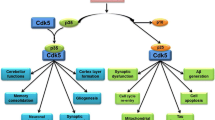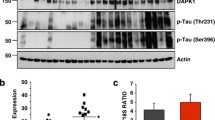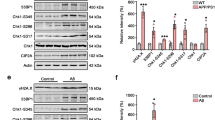Abstract
Tau hyperphosphorylation, amyloid plaques, and neuronal death are major neuropathological features of Alzheimer’s disease (AD) and Prion-related encephalopathies (PRE). Cyclin-dependent kinase 5 (Cdk5) is a serine/threonine kinase, active in post-mitotic neurons, where it regulates survival and death pathways. Overactivation of Cdk5 is conferred by p25, a truncated fragment of the p35 activator formed upon calpain activation. Cdk5 deregulation causes abnormal phosphorylation of microtubule-associated protein tau, leading to neurodegeneration. In this work we investigated the involvement of Cdk5 in the neurodegeneration triggered by amyloid-beta (Aβ) and prion (PrP) peptides, the culprit agents of AD and PRE. As a work model, we used cultured rat cortical neurons treated with Aβ1–40 and PrP106–126 synthetic peptides. The obtained data show that apoptotic neuronal death caused by both the peptides was in part due to Cdk5 deregulation. After peptide treatment, p25 levels were significantly enhanced in a pattern consistent with the augment in calpain activity. Moreover, Aβ1–40 and PrP106–126 increased the levels of tau protein phosphorylated at Ser202/Thr205. Cdk5 (roscovitine) and calpain (MDL28170) inhibitors reverted tau hyperphosphorylation and prevented neuronal death caused by Aβ1–40 and PrP106–126. This study demonstrates, for the first time, that Cdk5 is involved in PrP-neurotoxicity. Altogether, our data suggests that Cdk5 plays an active role in the pathogenesis of AD and PRE.








Similar content being viewed by others
References
Agostinho P, Oliveira CR (2003) Involvement of calcineurin in the neurotoxic effects induced by amyloid-beta and prion peptides. Eur J Neurosci 17:1189–1196
Aguzzi A, Haass C (2003) Games played by rogue proteins in prion disorders and Alzheimer’s disease. Science 302:814–818
Alvarez A, Munoz JP, Maccioni RB (2001) A Cdk5-p35 stable complex is involved in the beta-amyloid-induced deregulation of Cdk5 activity in hippocampal neurons. Exp Cell Res 264:266–274
Angelo M, Plattner F, Giese KP (2006) Cyclin-dependent kinase 5 in synaptic plasticity, learning and memory. J Neurochem 99:353–370
Ankarcrona M, Dypbukt JM, Bonfoco E, Zhivotovsky B, Orrenius S, Lipton SA, Nicotera P (1995) Glutamate-induced neuronal death: a succession of necrosis or apoptosis depending on mitochondrial function. Neuron 15:961–973
Barnham KJ, Cappai R, Beyreuther K, Masters CL, Hill AF (2006) Delineating common molecular mechanisms in Alzheimer’s and prion diseases. Trends Biochem Sci 31:465–472
Bautista MJ, Gutierrez J, Salguero FJ, Fernandez de Marco MM, Romero-Trevejo JL, Gomez-Villamandos JC (2006) BSE infection in bovine PrP transgenic mice leads to hyperphosphorylation of tau-protein. Vet Microbiol 115:293–301
Boland B, Campbell V (2003) Beta-amyloid (1–40)-induced apoptosis of cultured cortical neurones involves calpain-mediated cleavage of poly-ADP-ribose polymerase. Neurobiol Aging 24:179–186
Chae T, Kwon YT, Bronson R, Dikkes P, Li E, Tsai LH (1997) Mice lacking p35, a neuronal specific activator of Cdk5, display cortical lamination defects, seizures, and adult lethality. Neuron 18:29–42
Combs CK, Johnson DE, Cannady SB, Lehman TM, Landreth GE (1999) Identification of microglial signal transduction pathways mediating a neurotoxic response to amyloidogenic fragments of beta-amyloid and prion proteins. J Neurosci 19:928–939
Cruz JC, Tseng HC, Goldman JA, Shih H, Tsai LH (2003) Aberrant Cdk5 activation by p25 triggers pathological events leading to neurodegeneration and neurofibrillary tangles. Neuron 40:471–483
Dhavan R, Tsai LH (2001) A decade of Cdk5. Nat Rev Mol Cell Biol 2:749–759
Ferreiro E, Resende R, Costa R, Oliveira CR, Pereira CM (2006) An endoplasmic-reticulum-specific apoptotic pathway is involved in prion and amyloid-beta peptides neurotoxicity. Neurobiol Dis 23:669–678
Forloni G, Bugiani O, Tagliavini F, Salmona M (1996) Apoptosis-mediated neurotoxicity induced by beta-amyloid and PrP fragments. Mol Chem Neuropathol 28:163–171
Garcao P, Oliveira CR, Agostinho P (2006) Comparative study of microglia activation induced by amyloid-beta and prion peptides: role in neurodegeneration. J Neurosci Res 84:182–193
Gilmore EC, Ohshima T, Goffinet AM, Kulkarni AB, Herrup K (1998) Cyclin-dependent kinase 5-deficient mice demonstrate novel developmental arrest in cerebral cortex. J Neurosci 18:6370–6377
Grundke-Iqbal I, Iqbal K, Tung YC, Quinlan M, Wisniewski HM, Binder LI (1986) Abnormal phosphorylation of the microtubule-associated protein tau (tau) in Alzheimer cytoskeletal pathology. Proc Natl Acad Sci USA 83:4913–4917
Hardy J (2003) The relationship between amyloid and tau. J Mol Neurosci 20:203–206
Humbert S, Dhavan R, Tsai L (2000) p39 activates Cdk5 in neurons, and is associated with the actin cytoskeleton. J Cell Sci 113(Pt 6):975–983
Ishizawa K, Komori T, Shimazu T, Yamamoto T, Kitamoto T, Shimazu K, Hirose T (2002) Hyperphosphorylated tau deposition parallels prion protein burden in a case of Gerstmann-Straussler-Scheinker syndrome P102L mutation complicated with dementia. Acta Neuropathol (Berl) 104:342–350
Lee MS, Kwon YT, Li M, Peng J, Friedlander RM, Tsai LH (2000) Neurotoxicity induces cleavage of p35 to p25 by calpain. Nature 405:360–364
Lee VM, Goedert M, Trojanowski JQ (2001) Neurodegenerative tauopathies. Annu Rev Neurosci 24:1121–1159
Li T, Hawkes C, Qureshi HY, Kar S, Paudel HK (2006) Cyclin-dependent protein kinase 5 primes microtubule-associated protein tau site-specifically for glycogen synthase kinase 3beta. Biochemistry 45:3134–3145
Liu T, Perry G, Chan HW, Verdile G, Martins RN, Smith MA, Atwood CS (2004) Amyloid-beta-induced toxicity of primary neurons is dependent upon differentiation-associated increases in tau and cyclin-dependent kinase 5 expression. J Neurochem 88:554–563
Melo JB, Agostinho P, Oliveira CR (2007) Prion aggregation and neurotoxicity in cortical neurons. Ann NY Acad Sci 1096:220–229
Mosmann T (1983) Rapid colorimetric assay for cellular growth and survival: application to proliferation and cytotoxicity assays. J Immunol Methods 65:55–63
Nguyen MD, Mushynski WE, Julien JP (2002) Cycling at the interface between neurodevelopment and neurodegeneration. Cell Death Differ 9:1294–1306
Oddo S, Caccamo A, Kitazawa M, Tseng BP, LaFerla FM (2003) Amyloid deposition precedes tangle formation in a triple transgenic model of Alzheimer’s disease. Neurobiol Aging 24:1063–1070
Oddo S, Caccamo A, Shepherd JD, Murphy MP, Golde TE, Kayed R, Metherate R, Mattson MP, Akbari Y, LaFerla FM (2003) Triple-transgenic model of Alzheimer’s disease with plaques and tangles: intracellular Abeta and synaptic dysfunction. Neuron 39:409–421
Oddo S, Billings L, Kesslak JP, Cribbs DH, LaFerla FM (2004) Abeta immunotherapy leads to clearance of early, but not late, hyperphosphorylated tau aggregates via the proteasome. Neuron 43:321–332
O’Donovan CN, Tobin D, Cotter TG (2001) Prion protein fragment PrP-(106–126) induces apoptosis via mitochondrial disruption in human neuronal SH-SY5Y cells. J Biol Chem 276:43516–43523
Ohshima T, Ward JM, Huh CG, Longenecker G, Veeranna, Pant HC, Brady RO, Martin LJ, Kulkarni AB (1996) Targeted disruption of the cyclin-dependent kinase 5 gene results in abnormal corticogenesis, neuronal pathology and perinatal death. Proc Natl Acad Sci USA 93:11173–11178
Patrick GN, Zukerberg L, Nikolic M, de la Monte S, Dikkes P, Tsai LH (1999) Conversion of p35 to p25 deregulates Cdk5 activity and promotes neurodegeneration. Nature 402:615–622
Plattner F, Angelo M, Giese KP (2006) The roles of cyclin-dependent kinase 5 and glycogen synthase kinase 3 in tau hyperphosphorylation. J Biol Chem 281:25457–25465
Prusiner SB (1998) Prions. Proc Natl Acad Sci USA 95:13363–13383
Raynaud F, Marcilhac A (2006) Implication of calpain in neuronal apoptosis. A possible regulation of Alzheimer’s disease. Febs J 273:3437–3443
Riemenschneider M, Wagenpfeil S, Vanderstichele H, Otto M, Wiltfang J, Kretzschmar H, Vanmechelen E, Forstl H, Kurz A (2003) Phospho-tau/total tau ratio in cerebrospinal fluid discriminates Creutzfeldt-Jakob disease from other dementias. Mol Psychiatry 8:343–347
Selkoe DJ (1993) Physiological production of the beta-amyloid protein and the mechanism of Alzheimer’s disease. Trends Neurosci 16:403–409
Shelton SB, Johnson GV (2004) Cyclin-dependent kinase-5 in neurodegeneration. J Neurochem 88:1313–1326
Tsai LH, Delalle I, Caviness VS Jr, Chae T, Harlow E (1994) p35 is a neural-specific regulatory subunit of cyclin-dependent kinase 5. Nature 371:419–423
Tsai LH, Lee MS, Cruz J (2004) Cdk5, a therapeutic target for Alzheimer’s disease? Biochim Biophys Acta 1697:137–142
Tseng HC, Zhou Y, Shen Y, Tsai LH (2002) A survey of Cdk5 activator p35 and p25 levels in Alzheimer’s disease brains. FEBS Lett 523:58–62
Veerhuis R, Boshuizen RS, Familian A (2005) Amyloid associated proteins in Alzheimer’s and prion disease. Curr Drug Targets CNS Neurol Disord 4:235–248
White AR, Guirguis R, Brazier MW, Jobling MF, Hill AF, Beyreuther K, Barrow CJ, Masters CL, Collins SJ, Cappai R (2001) Sublethal concentrations of prion peptide PrP106–126 or the amyloid beta peptide of Alzheimer’s disease activates expression of proapoptotic markers in primary cortical neurons. Neurobiol Dis 8:299–316
Author information
Authors and Affiliations
Corresponding author
Rights and permissions
About this article
Cite this article
Lopes, J.P., Oliveira, C.R. & Agostinho, P. Role of Cyclin-Dependent Kinase 5 in the Neurodegenerative Process Triggered by Amyloid-Beta and Prion Peptides: Implications for Alzheimer’s Disease and Prion-Related Encephalopathies. Cell Mol Neurobiol 27, 943–957 (2007). https://doi.org/10.1007/s10571-007-9224-3
Received:
Accepted:
Published:
Issue Date:
DOI: https://doi.org/10.1007/s10571-007-9224-3




